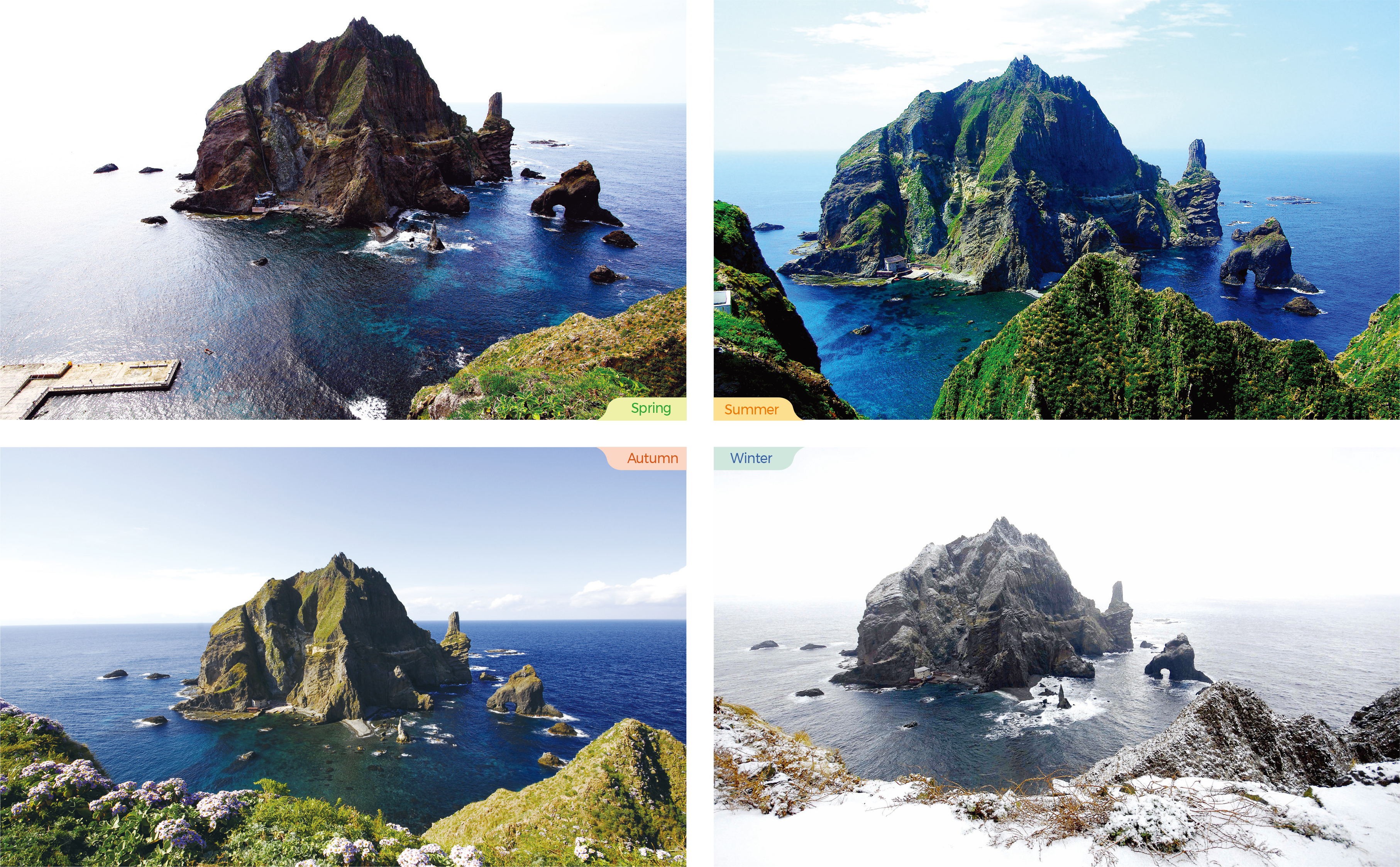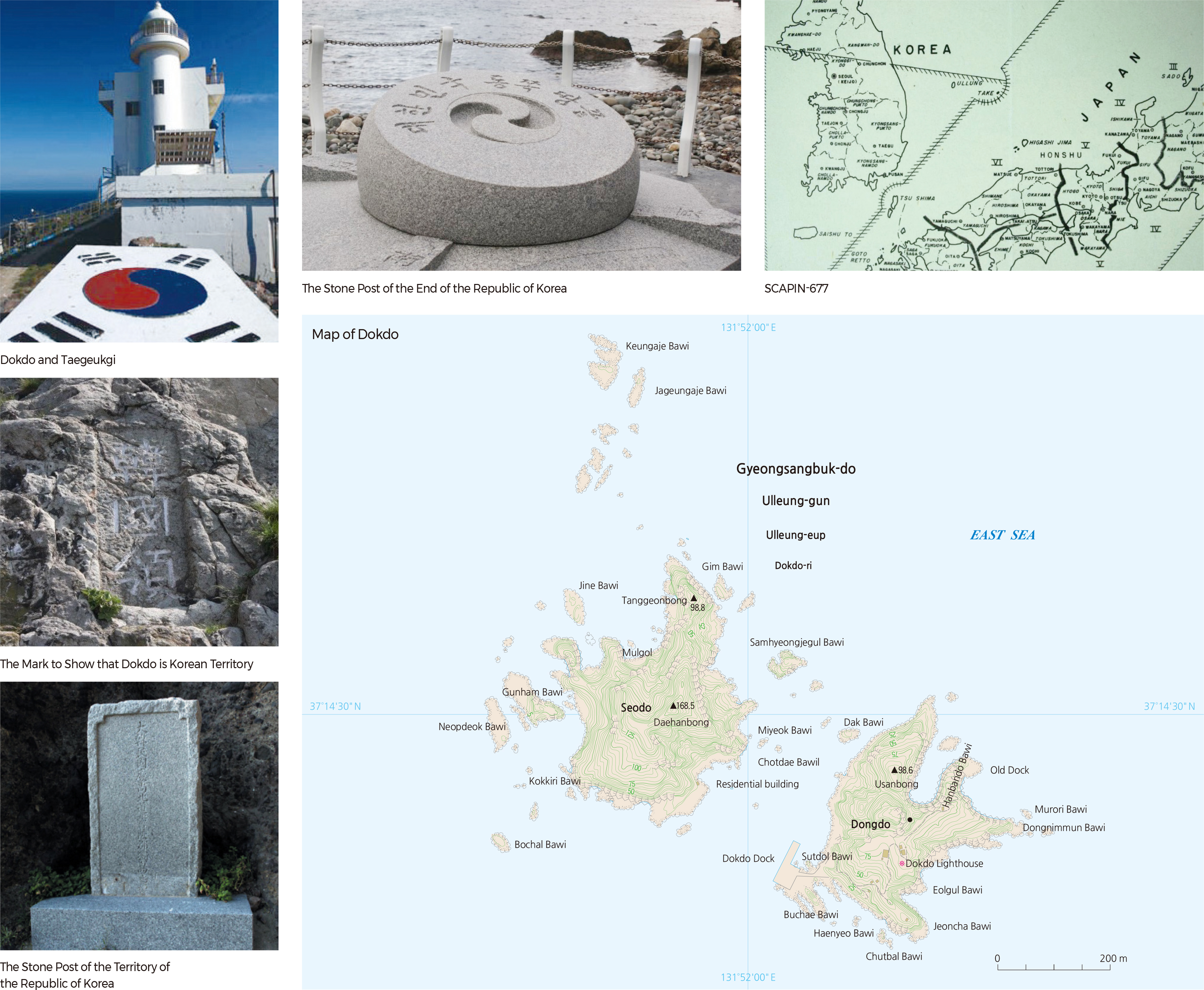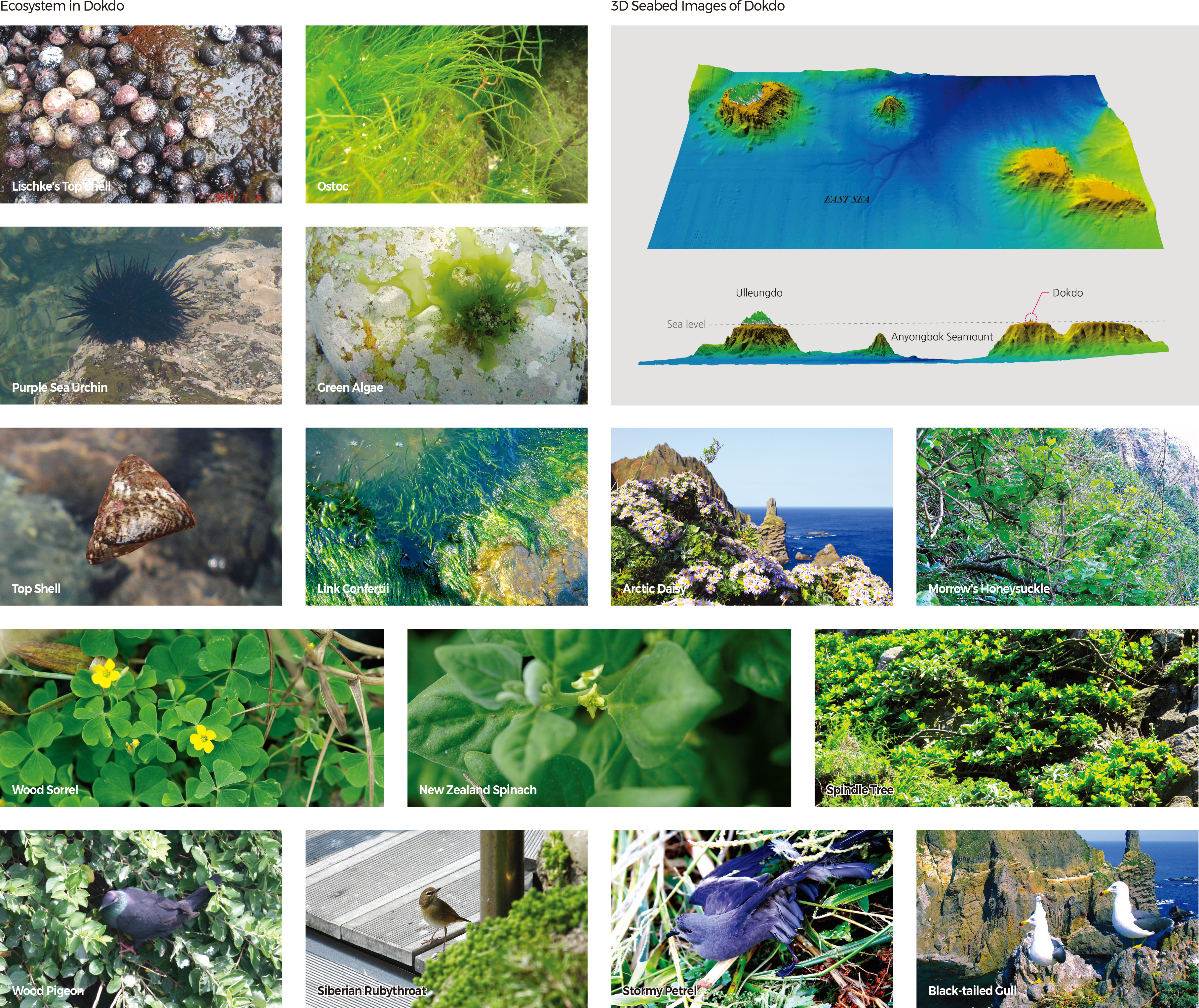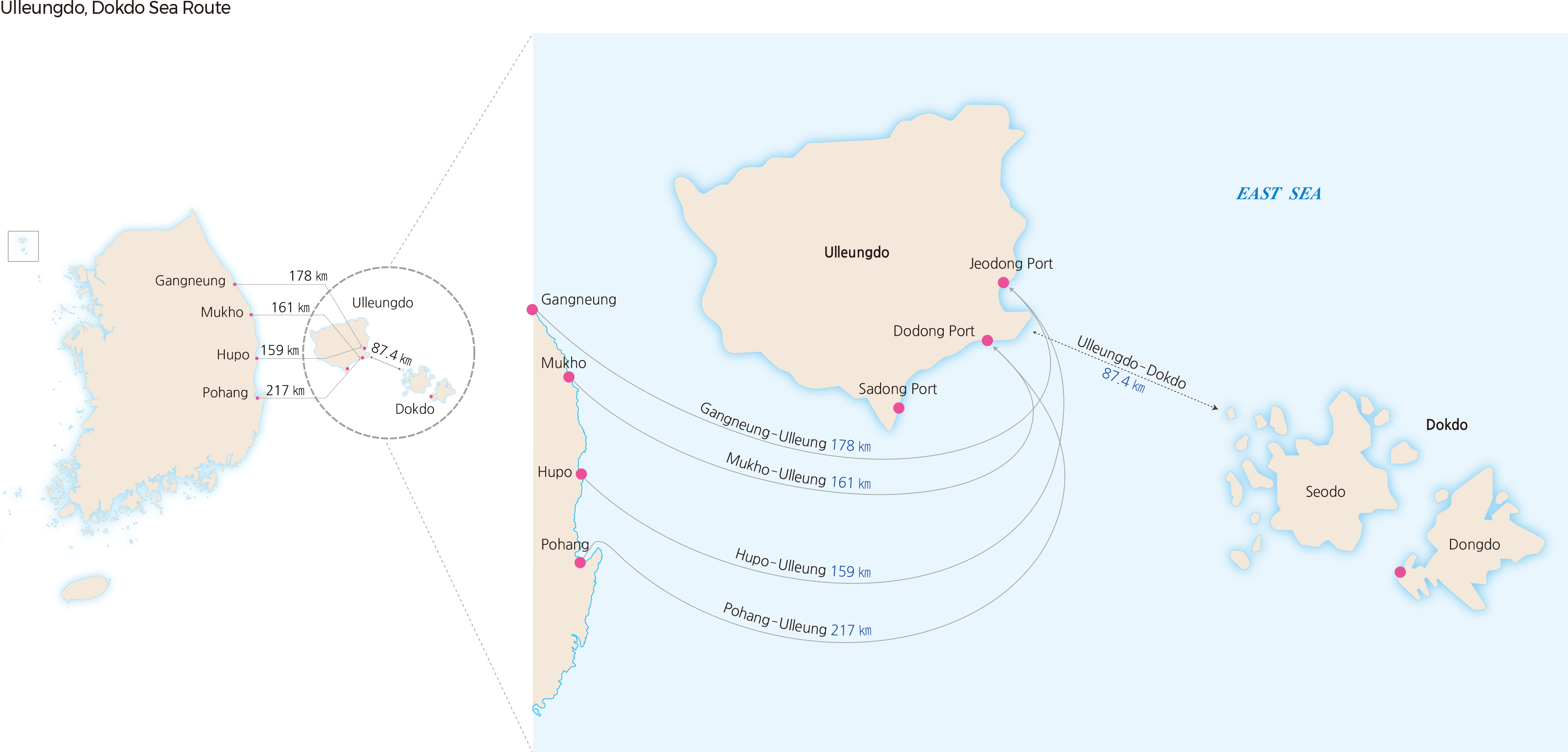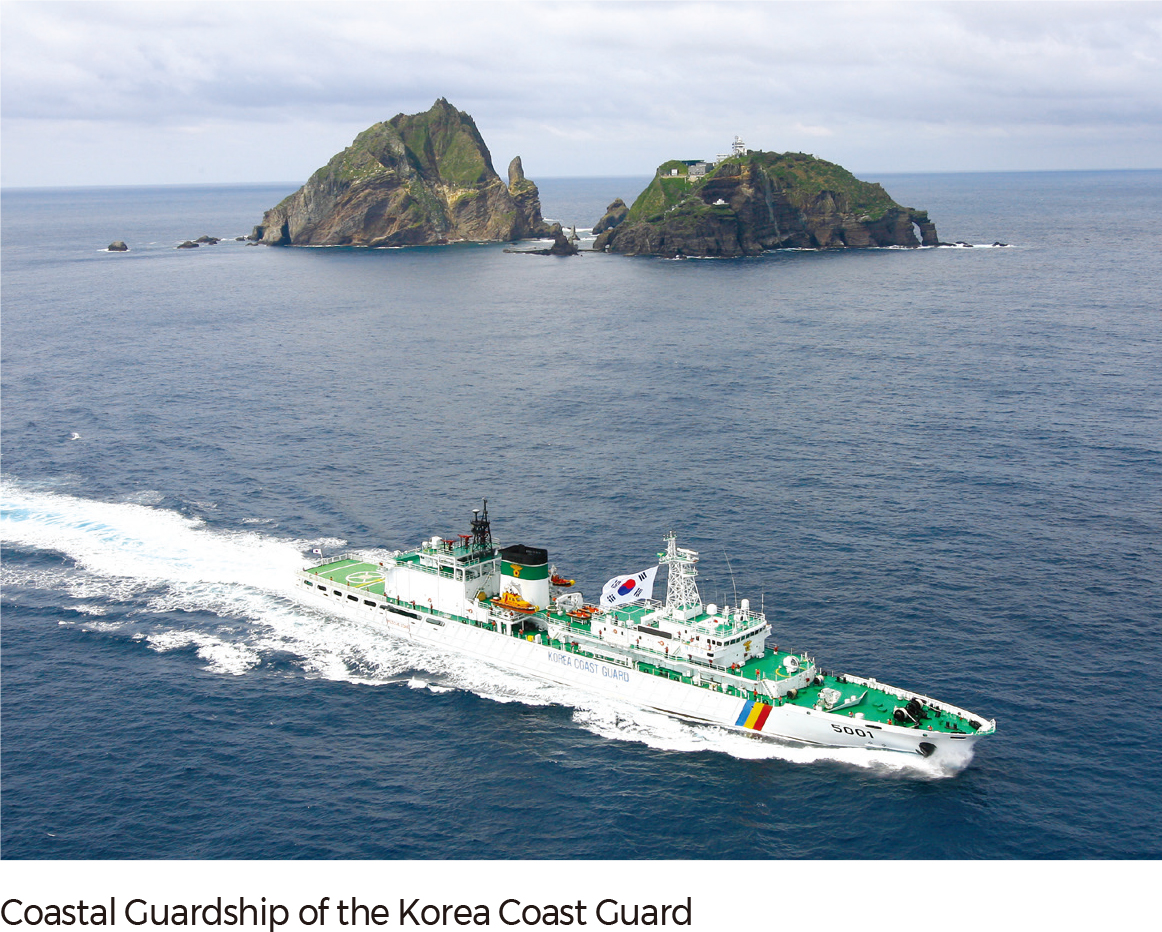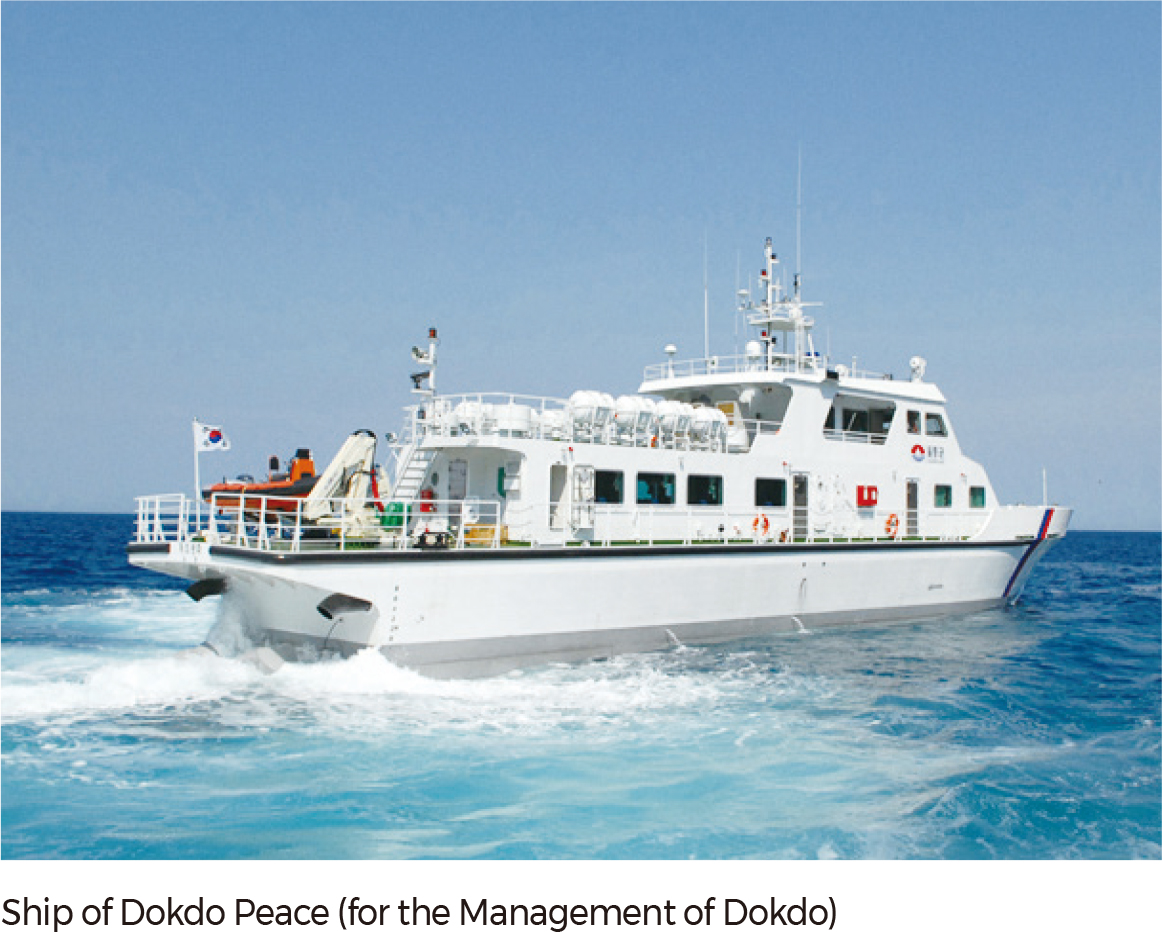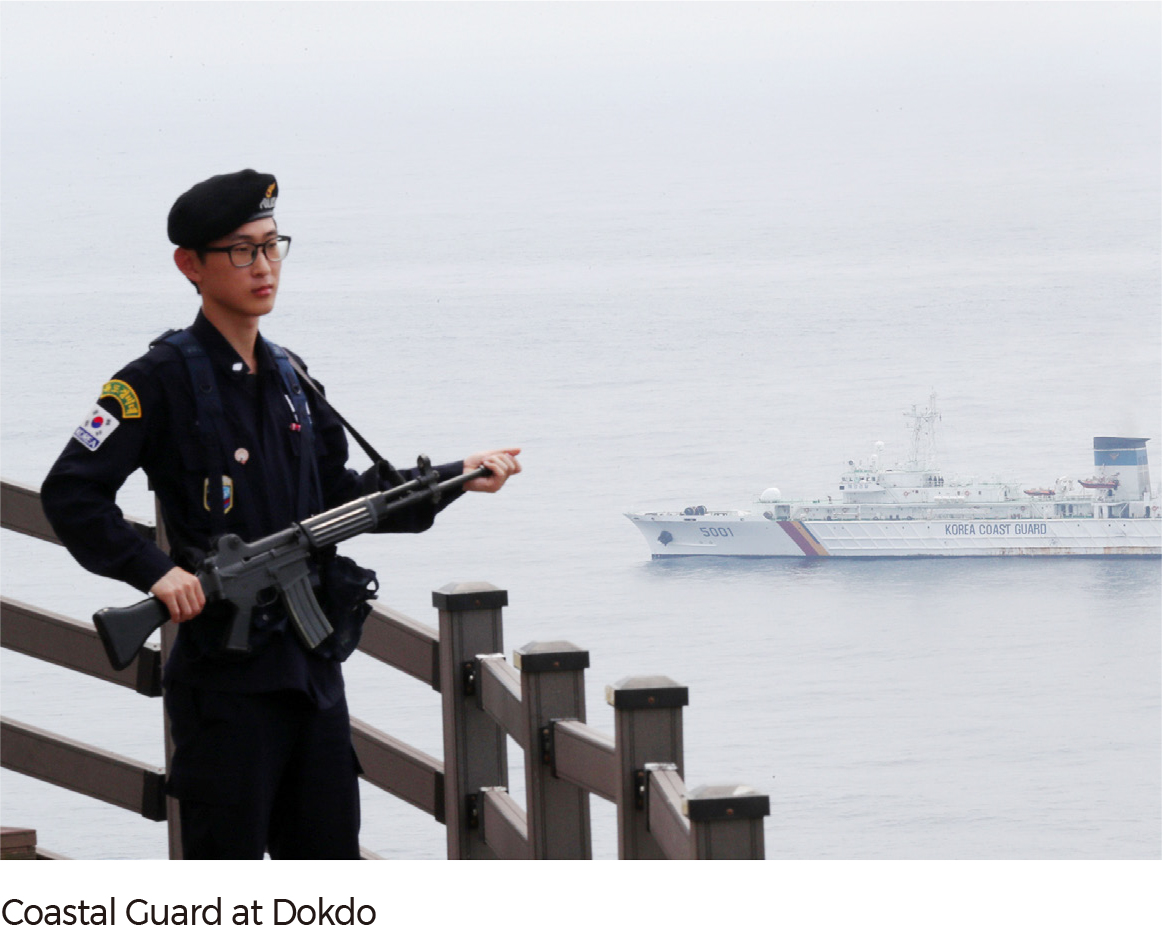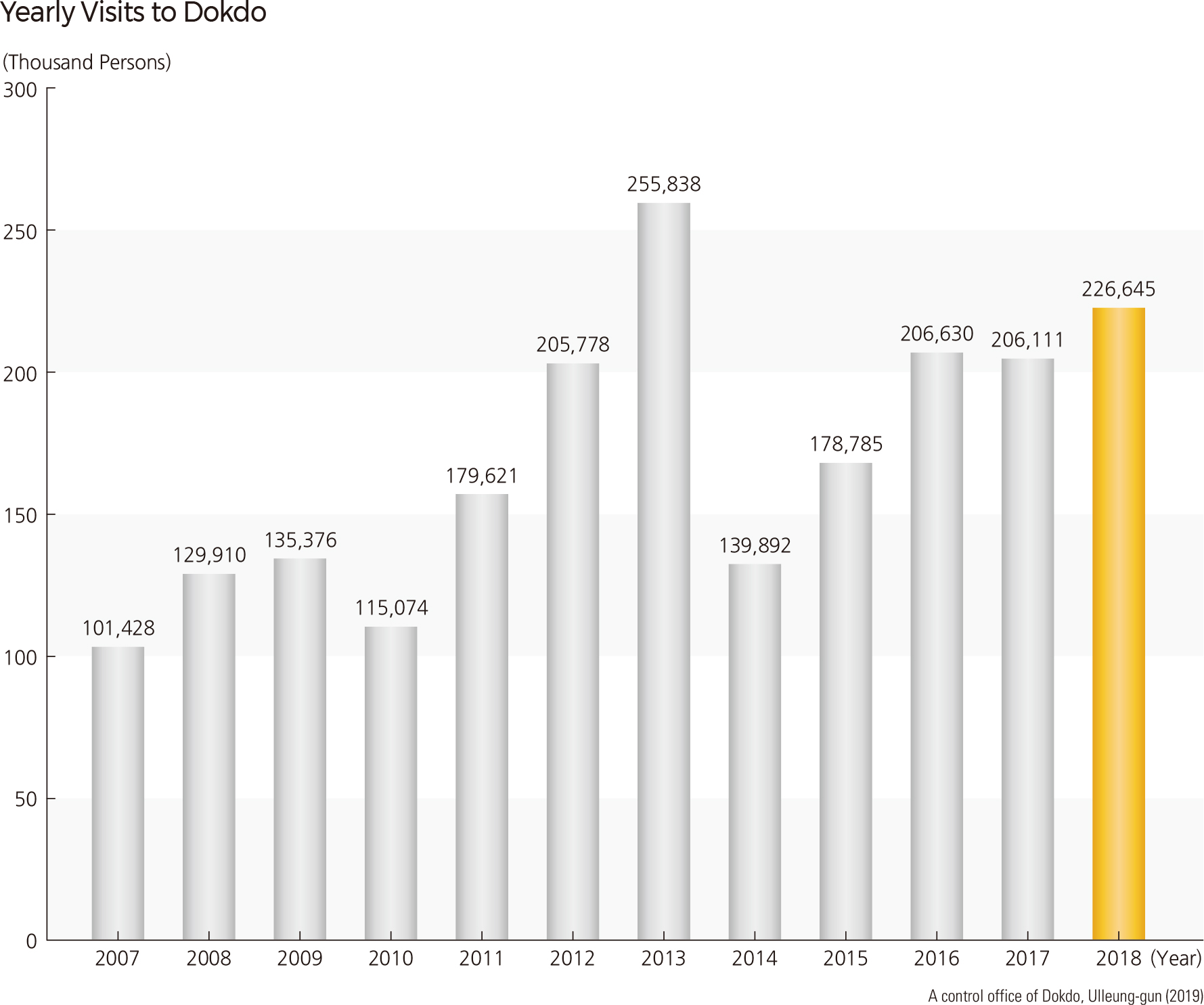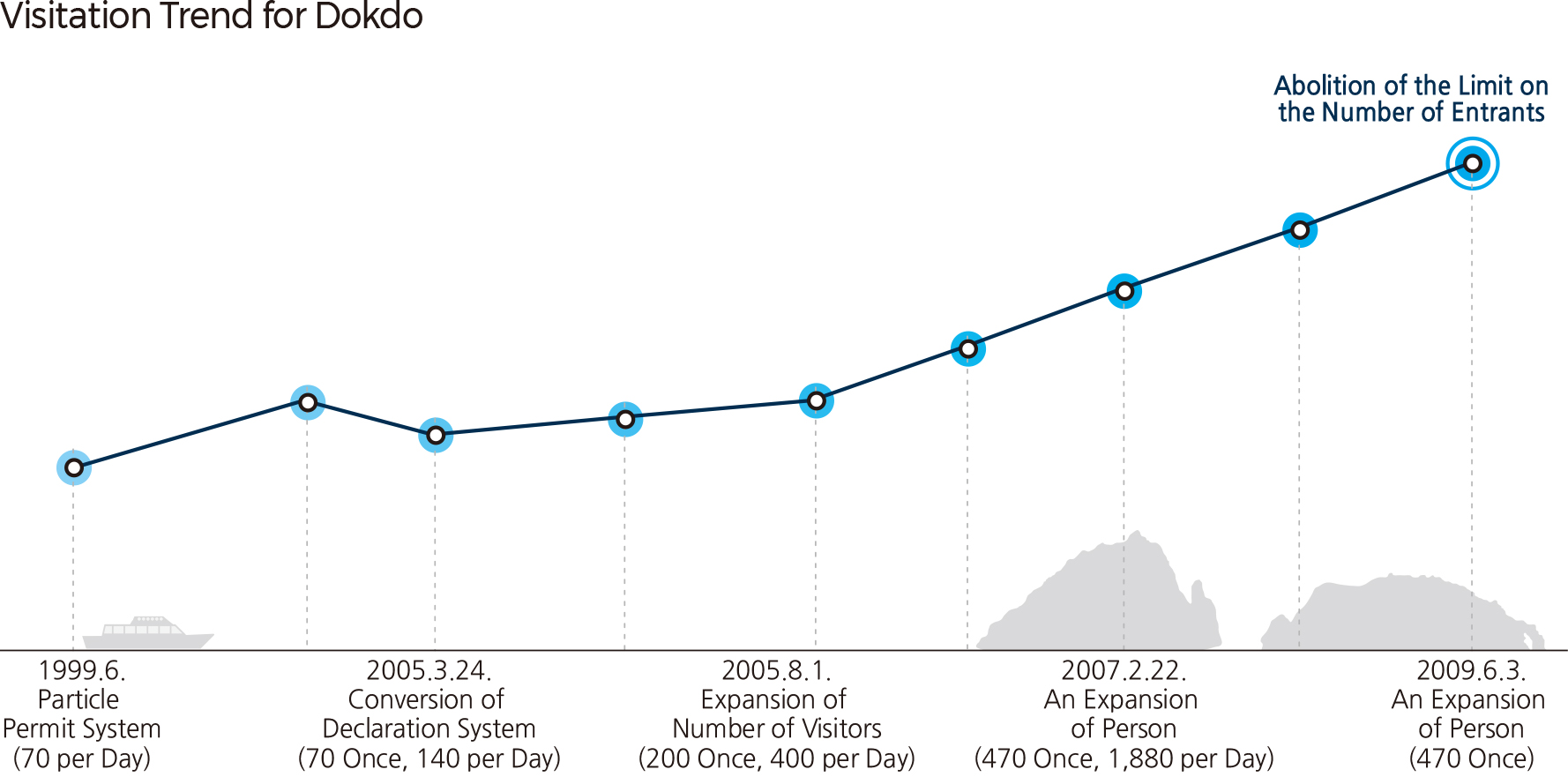English I 2019
Dokdo is an island of the Republic of Korea and is located at the easternmost edge of the national boundary in the East Sea, Dokdo-ri, Ulleung-gun, Ulleung-gun, and Gyeongsangbuk-do, Korea. Dokdo has been Korean Territory since General Isabu of the Silla Dynasty claimed Usanguk (The Kingdom of Usan) for Silla in 512. Dokdo has historically been referred to by various names such as Sambongdo, Gajido, Usando, Jasando, Seokdo, and currently Dokdo. According to Korean historical records, the administrative name of “Dokdo” was first used in 1906 by magistrate Sim Heung-taek of Ulleung-gun. Dokdo was officially incorporated into Gyeongsangbuk-do in 1914. Dokdo is not one island, but consists of two large islands, Dongdo (East Island) and Seodo (West Island), and 89 smaller islands, with a total area of 187,554 m².
The shortest distance between the two main islands is 151 meters at low tide. Dongdo is located at 37º 14′ 26.8″ N, 131º 52′ 10.4″ E, and Seodo is at 37º 14′ 30.6″ N, 131º 51′ 54.6″ E. Dokdo is 87.4 km east of Ulleungdo and 157.5 km northwest of Oki Island of the Shimane Prefecture of Japan. Dokdo is visible from multiple points on Ulleungdo, which has itself always been regarded as Korean territory. In the Sejong sillok jiriji (Geographical Records in the Annals of King Sejong, 1454), it is noted that the two islands of Usan (Dokdo) and Mureung (Ulleungdo) lay not far apart, and are visible to one another on a clear day.
The Korean government has confirmed through various historical archives that Korea has long recognized Dokdo as its territory. Along with the Sejong sillok jiriji, Sinjeung dongguk yeoji seungnam (The New and Expanded Complete Conspectus of the Territory of the Eastern Country, 1530), Dongguk munheon bigo (Reference Documents on the Eastern Country, 1770), Mangi yoram (Essentials of Governance, 1808), and Jeungbo munheon bigo (Comprehensive Study of Civilization, Revised and Expanded, 1908) all show consistency in depicting Dokdo as Korean territory. According to the Reference Documents on the Eastern Country, “Ulleung and Usan are part of the State of Usan, and Usan is referred to as Songdo by the Japanese,” reaffirming that Dokdo is Korea’s territory. In 1900, Emperor Gojong of the Korean Empire declared Ordinance No. 41, confirming that Dokdo is in the jurisdiction of Uldo-gun (Ulleungdo) and assigned the Mayor of Uldo-gun to administer Dokdo.
Even Japanese historical documents reveal that Dokdo has always been a part of Korean territory. In the late 17th century, the Joseon government and Edo Shogunate negotiated an agreement regarding illegal fisheries activities, which was called the “Ulleungdo Dispute.” As a result, the Edo Shogunate officially acknowledged on December 25, 1695, that both Ulleungdo (Jukdo) and Dokdo (Songdo) did not belong to the Tottorihan of Edo Shogunate and placed a ban on Japanese fishing in the Ulleungdo area. Despite that, Japan tried to illegally occupy Dokdo through the Shimane Prefecture Public Notice in 1905. However, the Japanese government acknowledged that Dokdo is the Korean territory before the notice was issued. Another notable example, confirming Dokdo as Korean territory, was the Dajokan Order of 1877, which was published by the Dajokan, the highest administrative organization of Japan at the time. Thus, Japan has acknowledged Korea’s sovereignty over Dokdo throughout history.
Multiple discussions on the international order before and after World War II have confirmed Korea’s sovereignty over Dokdo. The Cairo Declaration of December 1943 stipulated that “Japan shall be stripped of all islands she has seized or occupied by violence and greed.” The General Headquarters of the Allied Powers issued the two instruction codes SCAPIN-677 and 1033 in 1946 to exclude Dokdo from Japan’s governmental or administrative control. It was also re-affirmed by the Treaty of San Francisco in 1951.
Dokdo is a volcanic island that formed from lava that erupted from about 2,000 m below the surface of the East Sea. It presu-mably formed between 4.6 million and 2.5 million years ago. It is estimated to have been 2.5 million–10,000 years old when Ulleungdo was being formed. Dokdo’s geology is alkaline volcanic rocks: the main rocks above sea level are made of andesite, and below sea level, the rocks are believed to consist of basalt. Part of a gigantic, round volcano (the Dokdo Seamount), Dokdo’s highest point is more than 2,000 m above the seafloor, with the radius of the seamount being 30 km at the bottom. As the topographical map shows, the Simheungtaek and Isabu Tablemounts are in the eastern part of the Dokdo Seamount, while the Anyongbok Seamount is located between Ulleungdo and Dokdo.
Surrounded by the Korean Peninsula, Russia, and Japan, the East Sea where Dokdo is located belongs to the group of marginal seas in the North Pacific, running from the Okhotsk Sea to the South China Sea. The North Korea Cold Water (NKCW) and the East Korea Warm Currents (EKWC) meet in the waters around Dokdo, which is located at the center of the East Sea. The seabed in the East Sea near Dokdo consists of three topographic highlands and is more than 2,200 m deep in the west, getting shallower in the east. The strait between Dongdo and Seodo is 110–160 m in width, 330 m long, and 5–10 m deep. The waters near Seodo are shallower than those near Dongdo, but the depth of water off Dongdo reaches hundreds of meters.
The waters near Dokdo are rich in zooplankton and phytoplankton as the warm and cold currents circulate and meet. Good environmental conditions are maintained in large part due to their long distance from land. The sea around Dokdo is relatively undisturbed by human activities, and as a result, it is home to a large diversity of marine life. The waters around Dokdo are abundant with squid and many different types of fish. Squid accounts for more than 60% of the total catch in areas near Dokdo and Daehwatoe Fishery. The drift catches of ray, Korean anchovy, flatfish, saury, yellowtail, blowfish, sea eel, shellfish (such as abalone, conch, and muzzle), and seaweeds (such as sea mustard, kelp, agar, and fusiformis) are useful marine resources. Additionally, the trap fishery of red snow crab, shrimp, and sea cucumber results in millions of KRW in profit. As of 2018, 379 marine species have been recorded in Dokdo, which includes 220 invertebrate animal species, 110 marine plant species, 21 coral species, and 28 fish species. Most notably, marine plant species and coral species serve to create a rich habitat and spawning ground for a diversity of marine organisms. Additionally, the waters near Dokdo are rich in methane hydrate. Dokdo can be used to establish exclusive economic zone rights for Korea and also can play a pivotal role as an advanced marine base for the Pacific Ocean and a transportation hub in the East Sea.
Dokdo serves as a midpoint rest stop for several bird migration routes. As such, it also serves as an important natural laboratory for scientific research on these birds’ origins and population distribution. A 2005 study confirmed the existence of a total of 25 species of birds on Dokdo and that number increased to 76 in 2013. The huge difference in findings is attributed to the gap in bird species by season, and the variety and diversity of birds according to the research period and frequency. Twenty-two different species of birds are constantly found, and they include black-tailed gull, stormy petrel, shearwater, kestrel, osprey, dusky thrush, swan, harlequin duck, brambling, yellow-throated bunting, white-faced wagtail, golden-crested kinglet, and quail. Among them, the black-tailed gull has the largest population, followed by the stormy petrel, then the shearwater. Eight species are endangered: One 1st grade endangered species, the hawk, and seven 2nd grade endangered species, Siberian honey buzzard, black kite, crested murrelet, owl, osprey, swan, and hooded crane. The shearwaters, stormy petrels, and black-tailed gulls that call the island home only reproduce in Northeast Asia. Namsa-myeon of Seodo (Dokdo), the west region of Dongnipmun Rock, and the places where the perennial plant couch grass grows are known breeding grounds for the black-tailed gull. The island also welcomes for temporary stopovers migratory birds such as the common summer migratory birds (common sandpiper, cattle egret, heron, and streaked shearwater), common winter birds (dunlin, herring gull, and Korean buzzard) and others (snipe, gray-tailed tattler, and common greenshank).
A minimum of 34 species to a maximum of 75 species of plants on Dokdo has been researched by many different organizations; however, a total of 48 groups of species are acknowledged to inhabit Dokdo. Among them, the Ministry of Environment designated 13 groups of floristic regional indicator plants. Along with Japanese black pine, shrubs such as broad-leaf olive, broad-leaf spindle tree, honeysuckle, and herbaceous plants such as couch grass, aster, hare’s ear, false lily of the valley, holly fern, and red fescue are growing on the island. The honeysuckle is found only in Ulleungdo and Dokdo, and hare’s ear and false lilies of the valley have been designated and protected by the Ministry of Environment as preserved plants. Thirty-seven species of insects have been recorded in Dokdo, including dragonflies, earwigs, grasshoppers, cicada, beetles, flies, and butterflies.
Because of Dokdo’s migratory importance and species diversity, the government designated the islands as natural monument No. 336, and the Dokdo Natural Protection Zone was proclaimed on December 10, 1999, and expanded to 187,554 m² on September 14, 2006.
The Republic of Korea exercises its sovereign power over Dokdo by holding legislative, administrative, and judicial jurisdiction over it. First, there is a Korean police force stationed on Dokdo, patrolling the island. Second, the Korean military defends its territorial waters and airspace. Third, various laws and regulations of the Republic of Korea apply to the islands. Fourth, a lighthouse and docking facilities have been installed, and these facilities are managed and operated by Korea. Fifth, Korean civilians reside on Dokdo.
Dokdo is classified as an “Administrative Property” in accordance with Article 6 of the National Property Act (Management Office: Ministry of Oceans and Fisheries). It consists of 91 islands and 101 lots, and its publicly assessed and individual land prices were published. The construction of the docking facility on Dokdo was completed in November of 1997 and was registered in the cadastral records in August 1998. On March 20, 2000, the Ulleung-gun Council passed a bill “Pursuant to Act Amending Ri-Administration,” which was enacted on April 7th, 2000. The administrative designation of Dokdo’s addresses as 42-76, Dodong-ri, Ulleung-eup, Ulleung-gun, Gyeongsangbuk-do, Korea was adjusted to 1-37, Dokdo-ri, Ulleung-eup, Ulleung-gun, Gyeongsangbuk-do, Korea. With the adjustment in numbering system in Dokdo-ri since 2006, it was once again changed in 2016 to 1-96 beonji, Dokdo-ri, Ulleung-eup, Ulleung-gun. Again, with the newly-enacted Road Name Address Act, the new road names Dokdoyisabu-gil and Dokdoahnyongbok-gil were selected from a public contest and are in use. Therefore, the current administrative areas are 3, Dokdoahnyongbok-gil, Ulleung-eup, Ulleung-gun, Gyeongsangbuk-do (Residential Building); 55, Dokdoisabu-gil (Dokdo Coast Guard); and 63, Dokdoisabu-gil (Dokdo Lighthouse).
The first registered resident in Dokdo was Choi Jong-deok, and his address was 30 Dokdo-ri (San 67, Dodong-ri), Ulleung-eup, Ulleung-gun, Gyeongsangbuk-do. He moved from Ulleungdo to Dokdo in March 1965 to fish commercially and began the construction of facilities in May 1968. He was registered as a Dokdo resident on October 14, 1981, and died on Seodo Island on September 23, 1987. As of December 2017, the 65 permanent residents on Dokdo include 20 civilians (19 households), 40 Dokdo Coast Guard personnel, three lighthouse keepers, and two officers from the Ulleung-gun Dokdo Management Office. The number of applicants for honorary Dokdo citizenship, which is issued to those who enter and visit the island, numbered 45,000 as of March 2019.
Various government institutions have managed Dokdo for its use and operation. Gyeongsangbuk-do and Ulleung-gun are responsible for administrative services for the island, such as improving and supporting settlement and living conditions for the residents. The Dokdo Coast Guard is under the command of the Gyeongsangbuk-do Police Agency. The Ministry of Maritime Affairs and Fisheries offers directions for various activities allowing for the sustainable use of Dokdo and its surrounding waters in accordance with Law 7497 on the Sustainable Use of Dokdo Act, enacted on November 19, 2005. Major activities include ecosystem preservation, management, and protection of fishery resources; research and development of marine mineral resources; facility management plans on Dokdo; and the procurement of resources. In an effort to preserve the natural environment and the ecosystem of Dokdo, the Ministry of the Environment has designated Dokdo as a “specific island” in accordance with the Special Act on Preservation of the Ecosystem on Dokdo and Affiliated Islands. The Cultural Heritage Administration designated Dokdo as a natural monument according to the Cultural Heritage Preservation Act and protects the island. The Ministry of Information and Communication (currently the Korea Post) issued postage stamps depicting Dokdo in 1954, 2002, 2004, and 2007 and has established and is operating mail delivery services, including post boxes, on the island.
When Dokdo was first designated as a natural monument for its geological and ecological significance, the government restricted individual trips to the islets to protect the natural environment. As late as the early 1990s, it was difficult for civilians to visit Dokdo except for academic, administrative, or educational purposes. Since visits to the island were approved on an application basis, more people took an interest in Dokdo, and the number of visitors has increased. However, the numbers were limited to around one to two thousand every year until 2004. Since June 2005, the visitation ban was lifted for Dokdo, and the application-based visit became a reporting system. Tourism on Dokdo has ushered in a new era as passenger ships travel between Ulleungdo and Dokdo regularly. The number of visitors has jumped sharply, and the daily visitor quota was lifted, allowing up 1,880 people / day. However, it is still limited to 470 persons per group. As of December 2017, the number of visitors to Dokdo in 2017 reached 207,000, surpassing the 200,000 mark for the third consecutive year.
Those who wish to visit Dokdo need to go via Ulleungdo. Historically, the first liner services began between Ulleungdo and Busan in 1912, and services between Ulleungdo and Pohang began in 1963. These services brought expanded connectivity between Ulleungdo and the mainland. With the introduction of the 800 ton, high-speed passenger ships running this route, the number of tourists to Ulleungdo has drastically increased since 1977. Additionally, the travel time to Ulleungdo has decreased to around three hours. Eight passenger ships are in operation between Ulleungdo and Pohang, Mukho, Gangneung, and Uljin. The trip from all of these locations takes approximately 2–3 hours. For the route between Ulleungdo and Dokdo, six ships operate from March to November, departing from Dodong Port, Ulleungdo to Dongdo Dock, Dokdo, with the trip taking 1–2 hours. |

